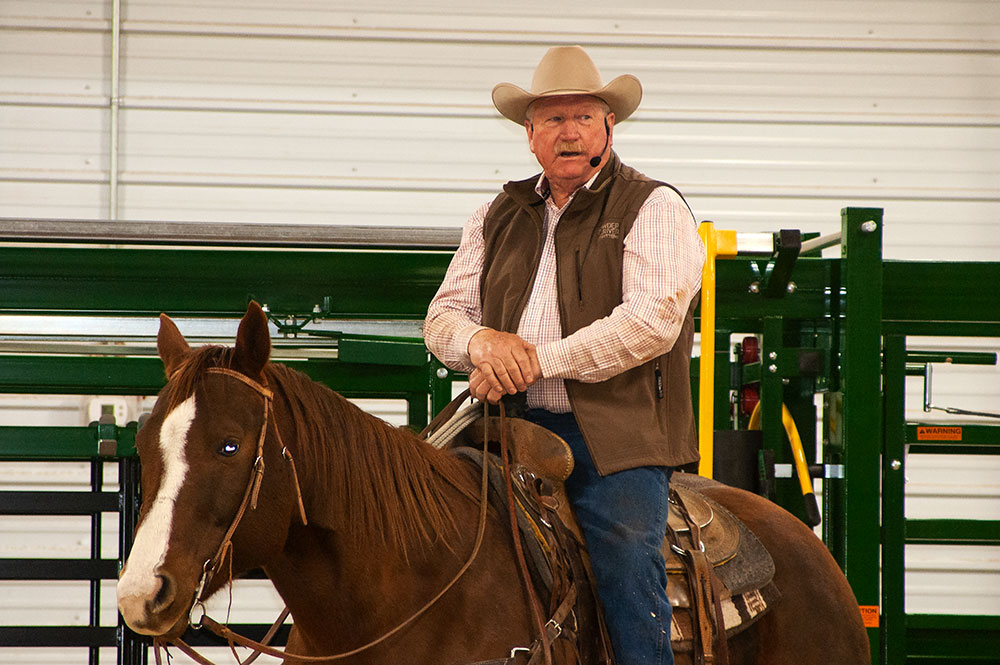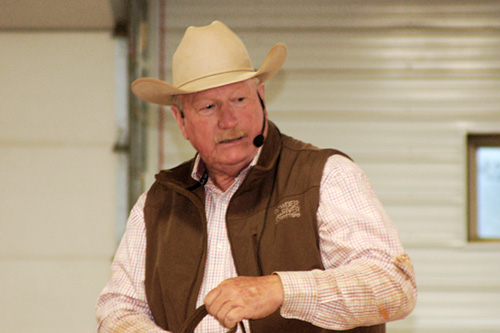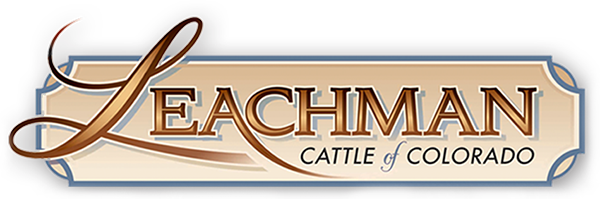
Using Effective Stockmanship
Keep principles of cattle behavior in mind when determining handler position and movement.
MITCHELL, NEB. (Nov. 18, 2019) — Stepping into the saddle, on an unfamiliar mount, Ron Gill grinned as he eased the borrowed horse around the arena. He said he appreciated the loan of a horse with some “feel” – one whose front end and rear end could be moved and repositioned to initiate and influence the flow of cattle.
“I want to be able to put the horse where I need to be. So the horse needs to be willing and pay attention, but not over-anticipate what we’re going to do next,” stated Gill. “I like working cattle from horseback and the advantage of height, so you can look over the herd. If you’re selling cattle, I think there’s an advantage in being able to work those cattle on foot, horseback or from an ATV.”
Gill, a Texas A&M AgriLife Extension livestock specialist and cattle handling expert provided a stockmanship demonstration during the 26th Range Beef Cow Symposium hosted Nov. 18-20 in Mitchell, Neb. He emphasized that however producer choose to work cattle, they should approach it with five basic principles of cattle behavior in mind:
- 1) Cattle want and need to see the handler.
- 2) Cattle want to move around the handler.
- 3) Cattle want to be with or move toward other cattle.
- 4) Cattle want to remove or get away from pressure.
- 5) Cattle can only think about one thing at a time.
“It’s because of those five things that everything we (as handlers) do affects how the cattle react,” emphasized Gill, while demonstrating how handler position and movement to apply and release pressure are influenced by animal flight zone and point of balance.
“If cattle are not working well, it’s because we’re not in the right place,” he added.
Gill sated his belief that some people have misunderstood so-called low-stress stockmanship concepts, thinking that cattle must be worked at a snail’s pace. It’s not just about doing things slowly. It’s more about controlling cattle flow by applying measured pressure — bolder movements for gentle cattle and smaller movements for flighty animals — to initiate and maintain flow. When skilled handlers work with responsive animals, cattle can flow quite swiftly.
 |
“If cattle are not working well, it’s because we’re not in the right place,” explained Ron Gill, Texas A&M AgriLife Extension livestock specialist and cattle handling expert. |
“It’s really about effective stockmanship. That’s what creates a low-stress situation,” said Gill. “How we do whatever we do is what creates much of the stress cattle experience.”
You can listen to this presentation by accessing the audio in the Newsroom at www.rangebeefcow.com.
Editor’s Note: This summary was written under contract or by staff of the Angus Media, which retains the copyright. To request to reprint this article, contact Shauna Rose Hermel, editor, at 816-383-5270. PowerPoints are posted with permission of the presenter and may not be reproduced in whole or in part without the express permission of the presenter. Angus Media claims copyright to this website as presented. We welcome educational venues and cattlemen to link to this site as a service to their audience.
Angus Media's coverage of the event is made possible through collaboration with the event committee and via sponsorship of Leachman Cattle of Colorado. For questions about this site, or to notify us of broken links, click here. Look for additional coverage in the Angus Journal, the Angus Beef Bulletin, the Angus Journal Daily, and the Angus Beef Bulletin EXTRA.



